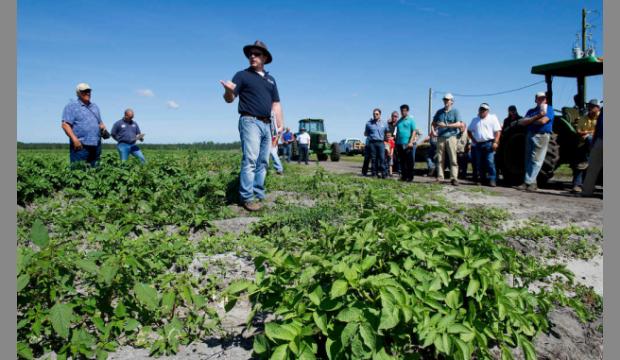With harvest time approaching — or already arrived — local potato farmers, researchers and those in the farming industry recently spent a few hours together in Hastings collaborating on ways to make the business even better.
St. Johns County and the University of Florida hosted the annual Potato Field Day event Tuesday at the UF/IFAS Hastings Agricultural Extension Center.
Potatoes are a big deal in St. Johns County, and production here is important to the rest of the country.
Bonnie Wells, a local agriculture agent with UF, said about 30 percent of the spring potato crop in the United States comes from the region. So whatever happens on local farms has an impact on the entire industry.
But Wells said one of the biggest growth areas is right here because of the movement in customer preference for locally grown food.
“Local markets are what they’re gaining in,” Wells said. “That movement has been huge for agriculture.
“What I’ve found, people are getting to where organic doesn’t really matter, but they just want to know where (the food) comes from.”
According to the 2012 Census of Agriculture, produced by the U.S. Department of Agriculture, St. Johns County was the No. 1 producer of potatoes and cabbages in the state. More than 14,000 acres of farmland in the county were devoted to growing potatoes.
Flagler County agriculture agent Mark Warren was among the presenters Tuesday, showing how to test potato plants for appropriate nitrogen levels. Nitrogen is essential for the proper maturation of the crop.
Warren said the spring potato market is worth about $112 million in the tri-county area of Putnam, Flagler and St. Johns.
Fellow agriculture agent Tim Wilson, who helped organize Tuesday’s event, said sharing ideas with farmers is good for them and equally beneficial to the UF researchers — several of whom made presentations at the event.
“The bulk of potatoes grown in Northeast Florida are grown in these three counties (St. Johns, Putnam and Flagler),” Wilson said. “These guys all know each other, and you don’t just kind of potato farm. You either do it or you don’t.
“This gives these growers a chance to break away, come talk to these experts, all of them in one spot, and really connect.”
The academic leaders addressed relevant topics like fertilizer use, herbicides, strategies to fight blight and the cultivation of different varieties of potatoes.
The development of new types of potatoes is the area of expertise for John-Thomas Dusing with Hanse Seed Corp. of Germany.
He travels all over North America to find out what potato farmers are looking for and what the market demands.
“Florida is just a very important piece in the puzzle of the potato business,” Dusing said. “Florida will give us fresh and new potatoes during the times when in the north, everybody’s planting. That’s why it’s important that we improve varieties just for this area.”
Among the most successful varieties is the Satina, a potato with yellow flesh and yellow skin. It’s been around since 2002. It’s popularity among yellow potatoes is surpassed only by Yukon Gold.
“Even though it (Satina) is the biggest variety and even though everybody is more or less happy, we need to show them (farmers) improvement,” Dusing said.
Getting the chance to meet growers and listen to their concerns is Dusing’s top priority.
“This is the most important thing I do in the year,” said Dusing, who will make similar trips later in the year to potato-growing regions like California, Idaho, Wisconsin and Washington. “Every area is different.”
Orignally published at the St. Augustine Record


